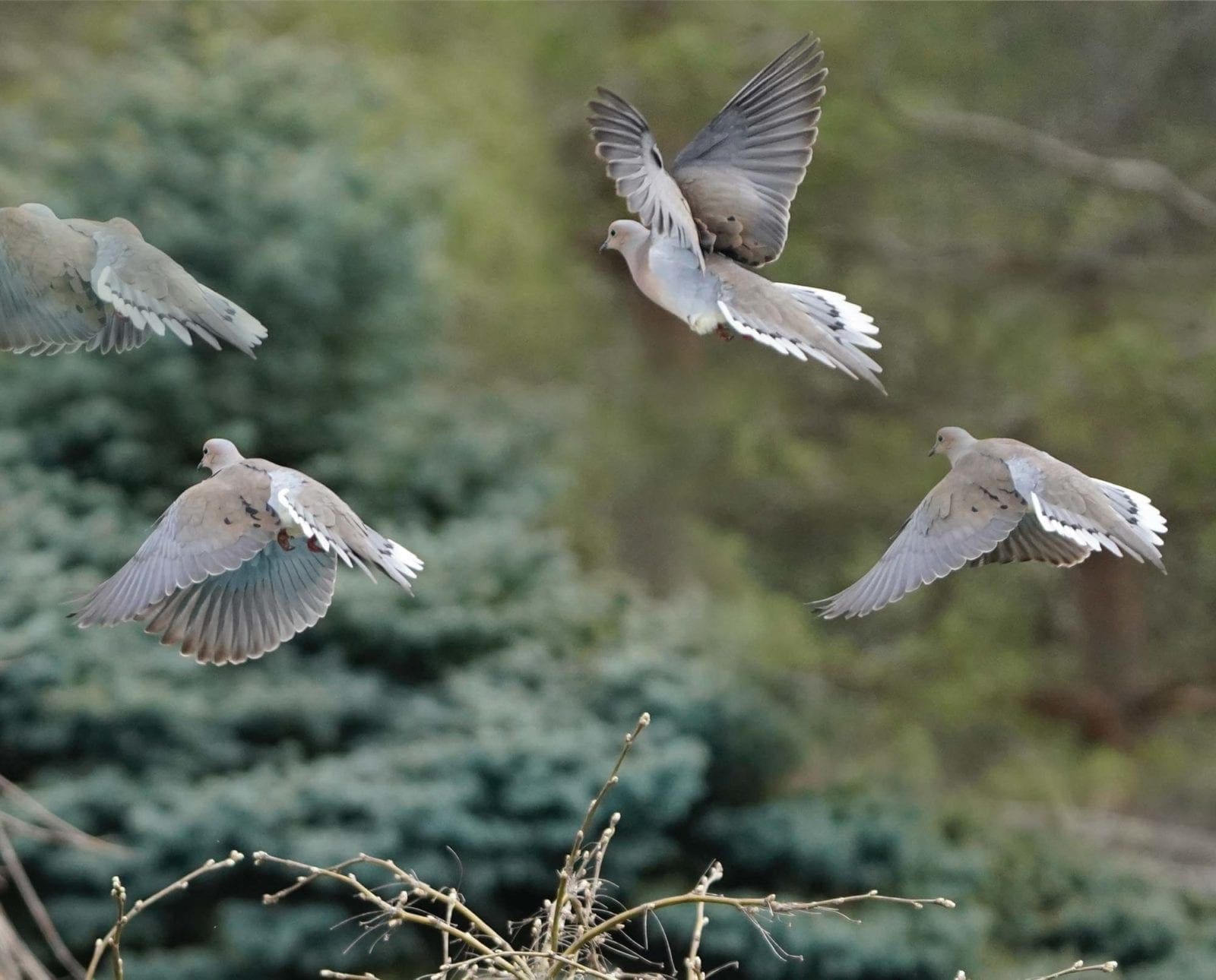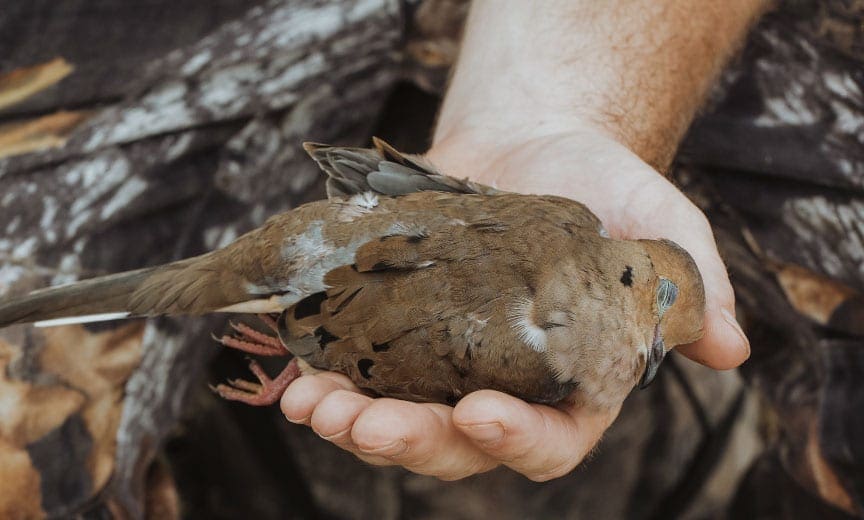Home » Dove Hunting » A Complete Guide to Dove Hunting
A Complete Guide to Dove Hunting

Edgar Castillo is a recently retired law enforcement officer for…
Explore dove hunting tactics, gear, seasons, and more in this complete guide to dove hunting
If you are new to wingshooting, then dove hunting is the perfect introduction for first-timers wanting to get into bird hunting. It lays the basic foundation for all the other upland disciplines. It’s a laid-back and enjoyable experience for beginners, and it’s a social hunting event. The action can go from zero to sixty in nothing flat.
Depending on where you live in the United States, the seasons and species for dove hunting fill up all 365 days a year offering a wide variety of situations and experiences to help fill the gaps of other bird hunting pursuits. From the iconic mourning dove, to the year round season of the invasive Eurasian collared dove the fun and food can be never-ending. To other less known species like the white-winged dove.
Dove hunting is as simplistic as you are going to get. The basic premise for dove hunting includes carrying a shotgun from a vehicle to a field, sit (bucket) or stand, wait for passing or decoying doves to fly close, and shoot. That, in a nutshell, is Dove Hunting 101. Just like in any type of hunting, there are those that go “all out” when dove hunting, but it is not necessary to do so. So, how do you get started?
Dove season dates and licenses
September 1st is the day that signals hunting season has begun! For a first-time dove hunter, the first thing at the top of the list should be to check season dates. Some states have an early and a late dove season. Being familiar with regulations is very important. Checking the state game and fish websites or visiting the local office should provide all the information needed. Most sites will also provide photos for proper dove identification.
Besides purchasing a regular hunting license, dove hunters are required by law to participate in the Harvest Information Program (HIP). This may require buying an additional permit or “stamp” if hunting migratory birds— dove, coot, rail, snipe, sandhill crane, waterfowl, and woodcock. Typically, the cost is only a couple of dollars. When the stamp is purchased, hunters will be asked to indicate which birds were hunted the previous year. At the end of the hunting season, HIP stamp purchasers will be randomly surveyed by the U.S. Fish and Wildlife Service. Responding to the survey provides important information for setting and justifying future migratory game bird seasons.
Choosing a shotgun for doves
Is there such a thing as a perfect shotgun for hunting doves? Maybe, but the truth is nearly any shotgun will work. If each hunter could draw up their ideal shotgun for dove hunting, you would get hundreds of different opinions, each one valid. Beginners shouldn’t allow themselves to get sucked into the “shotgun vortex” that defines what gun to use for dove hunting.
For the beginner, any shotgun that’s available will work. Most shotguns will be in the 12- or 20-gauge range. Whether owned or borrowed, these gauges will be the norm in most dove fields. Yes, once in the field, an array of shotguns will echo their presence—from hand-me down wooden pumps to slick black and camouflaged semi-autos, to single-shots and doubles, to over/unders and side-by-sides. Gauges will read like a ruler: 12-, 16-, 20- and 28-gauges and .410 caliber. All are great choices but the 28 and .410 are going to be carried by those with years of experience shooting grey rockets with little toy-like cartridges.
New dove hunters should be aware that repeating shotguns, which include both pump action and semi-automatic, have tubular magazines. These types of shotguns MUST be limited to holding only three shotshells (“plugged”) while dove hunting. Federal regulations require that when hunting migratory birds, the tubular magazine must have a plug inserted so that the total holding capacity of the shotgun does not exceed three shot-shells (one in the chamber, two in the magazine).
Beginners shouldn’t allow choosing a shotgun to be difficult. Use what you have or what you can get your hands on. As with learning anything new, ask a hunting mentor for assistance and advice.
READ: Choosing a Shotgun for Dove Hunting
Choosing ammunition and chokes for dove
If choosing a shotgun for dove hunting is confusing, then staring at all the variety of shotshells will send a new dove hunter into a frenzied panic. Take a deep breath and step back. Novice dove hunters will see an array of colorful cardboard ammo boxes adorned with artwork and photos of flying doves and with alluring words such as “dove” and “small” Game Loads.
READ: What Chokes and Shot Size to Use for Dove Hunting
Regardless of the temptation, beginners should stick to the most popular of the smaller shot sizes: 7, 7-1/2, or 8s. This range of shot is best suited for both early and late season doves. It doesn’t take a whole lot of pellets to bring down a dove, and smaller shot sizes offer more pellets down range. Because doves are fast flyers and tricky to hit, open shotgun chokes such as Improved Cylinder or Modified are recommended to allow the pellets to spread out and create a larger, more open pattern.
Dove hunters should pay attention to area rules and regulations pertaining to the type of shot allowed. While lead is still the most popular, shooters should check their respective state regulations. Many areas managed by the state require steel or other non-toxic shot (tungsten or bismuth) when dove hunting on public accessed lands.
READ: Why I Stopped Shooting Lead at Doves
Shooting skills are a factor for each dove hunter. Shooters should bring along more ammunition than they think they’ll need as September speedsters can prove even the most skilled wingshooter wrong.

Dove hunting clothing
Let’s be real: a pair of jeans (earth tones if possible) and a camo shirt will work. I know I may get some flack for saying that, but truth be told, khaki or brown pants paired with a green shirt or whatever camouflaged pattern of the day is can be worn effectively on a dove hunt. Dove hunters should find some type of camo or earth tone bird vest or wingshooters belt to carry the basic essentials such as ammo, doves, and water. Dove hunters should locate a good place to conceal themselves and wait until it’s time to pull the trigger. Enough said.
Where to dove hunt
Dove hunting is as simple as finding a location where doves are congregating and feeding. Harvested wheat stubble or corn silage fields, ponds with exposed banks and weed cover, and harvested sunflower fields are all excellent locations to target. Refer to state websites again and check for state-managed dove fields on publicly-accessible lands.
Read: How to Identify Mourning Dove Habitat
Basic dove hunting methods
Pass-shooting (shooting birds as they fly over) is probably the most common method of hunting doves. If hunting in the morning, dove hunters should set up no later than sunrise. Evening shooters will be most successful right before dusk. Both beginners and experienced dove hunters must resist the temptation to fire off rounds until doves cross into range. This means knowing the effective range of your choke. For most, that’s forty yards or less.
The other method is to use dove decoys to draw them in close for possible shots. Motion dove decoys are best, as movement lures doves in. Adding a few stationary decoys will add to the overall effectiveness.
READ: Duping Doves with Decoys – The Three D’s
For those that cannot sit still you can explore the idea of walking up doves while hunting.
Eating dove is delicious
For beginning dove hunters, whether it’s a small pile or a limit of grey birds, cooking up doves is the culmination of a successful hunt. The easiest way to savor those tasty doves is also the traditional way—wrap ’em up in bacon with a slice of jalapeño. As any dove hunter knows, there’s no greater mouth-watering delicacy!
To find our more about dove hunting on Project Upland check out the category: Dove Hunting
Edgar Castillo is a recently retired law enforcement officer for a large Kansas City metropolitan agency. He also served in the United States Marine Corps for twelve years. Edgar longs for the colors of autumn and frosty, winter days so he can explore the landscapes in search of wild birds in wild places. His passion lies in the uplands as he self-documents his travels across public lands throughout Kansas hunting open fields, walking treelines, & bustin’ through plum thickets.






Great article. Gets me excited for September and getting out with a social group of experienced and rookie dove hunters alike
Thanks Kyle! Dove hunting is a social affair and a great way to get back into hunting after a long summer and an excellent way to introduce new bird hunters into wingshooting.
I’ve been jacked up and ready since last November’s hunt. New gun and a new year. I’m chomping at the bit.
Thanks for adding fuel to the fire!
You’re quite welcomed Geoff. I think we all are as September slowly begins to show itself on our calendars. Look for more upcoming articles during dove season and one that could motivate you for the upcoming quail season.